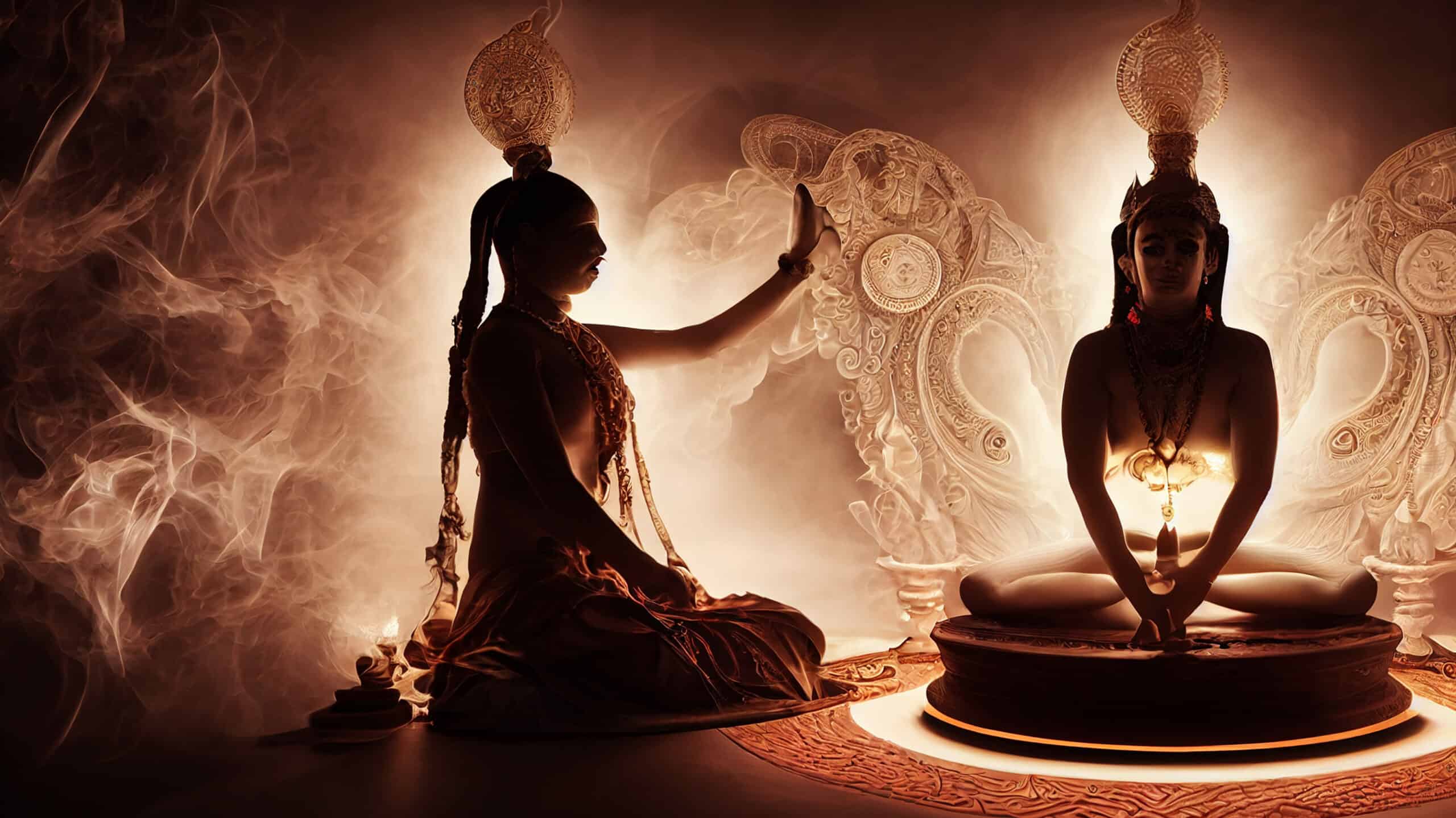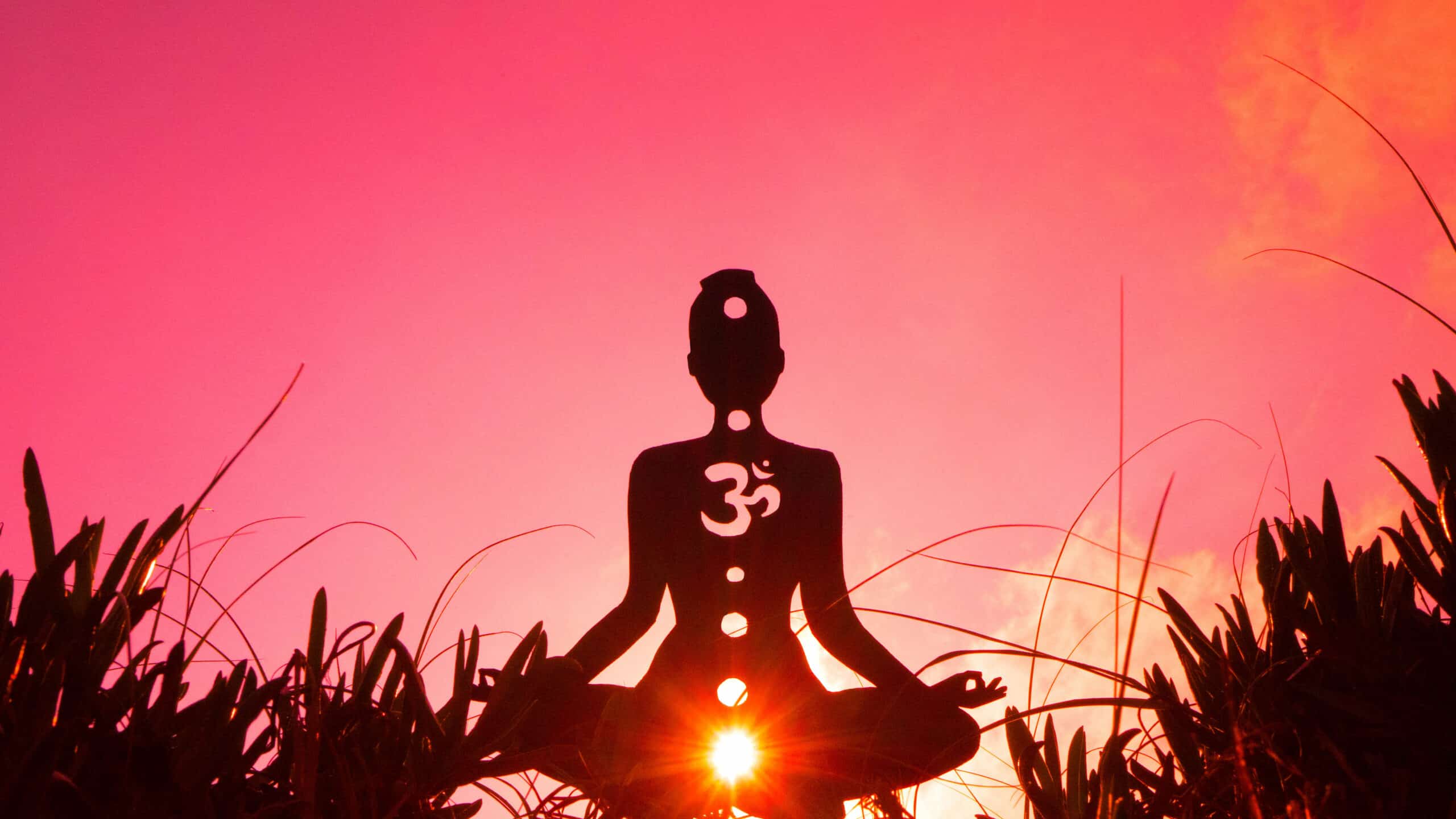Embarking on a journey to explore Tantric Breathing Techniques can lead you towards profound spiritual growth and enhanced well-being. This ancient Indian practice goes beyond mere physical pleasure, encompassing the harmonization of energies within oneself and with others.
Discovering this post will shed light on the significance of Kundalini power in Tantric approaches, as well as particular breathing exercises such as Alternate Nostril Breathing (Nadi Shodhana) and Breath Retention (Kumbhaka). These techniques are designed to merge your energies for heightened experiences of oneness.
In addition to mastering Tantric Breathing Techniques, visualization practices play a significant part in achieving deep connections with yourself and others. We will discuss various methods that help expand your awareness while preparing your body through Hatha Yoga Asanas for increased flexibility and strength.
Lastly, we’ll address how to integrate these principles into daily life through mindfulness techniques and applying tantra in relationships and work settings. Overcoming obstacles like emotional blockages or maintaining consistency in practice is crucial for success on this transformative path.
Understanding Tantra and Oneness

Tantra is a system of yoga that embraces all aspects of life, aiming to merge Shiva (masculine energy) and Shakti (feminine energy) within ourselves. This union leads to the experience of oneness or samadhi, where we connect with Brahma, the universal source energy. By applying tantric concepts to our daily lives, we can gain a more profound comprehension of ourselves and our connections while improving overall health.
The Origins of Tantra
Tantra has its beginnings in the distant past, originating from Indian tradition. It is often associated with sacred sexuality and tantric sex, but it encompasses much more than just physical pleasure. The primary goal in tantra is spiritual growth through the integration and balancing of opposing energies within us.
Merging Shiva-Shakti Energies for Oneness
In order to achieve oneness through tantra, one must learn how to balance their masculine (Shiva) and feminine (Shakti) energies. Regardless of one’s gender identity or sexual orientation, the balance of Shiva and Shakti energies within us is essential for achieving oneness through tantra. When these energies are balanced harmoniously within us, we can access higher states of consciousness such as deep meditation or samadhi.
- Shiva: Represents pure consciousness; symbolizes stability, structure, discipline;
- Shakti: Represents creative power; symbolizes movement, changeability;
Finding Balance Through Tantric Practices
To cultivate this inner harmony between Shiva and Shakti energies, one can engage in various tantric practices such as deep breathing exercises, meditation, and yoga. These techniques help to quiet the mind and allow us to connect with our true essence. By integrating these practices into our daily lives, we can maintain a balanced state of being that promotes overall wellness.
Gaining insight into Tantra and Unity can be a potent exercise that facilitates the cultivation of cognizance about the interconnection among all living things, enabling us to go beyond our particular outlooks. Kundalini energy plays a major role in tantric practices as it can be used to awaken one’s spiritual potential and access higher states of consciousness.
The Role of Kundalini Energy in Tantric Practice

Located at the base of the spine, Kundalini energy is a key component in tantric practice. Through tantric breathing practices, this dormant power can be awakened and released through our chakras to reach higher states of consciousness. Grasping the idea of Kundalini and its link to chakras is fundamental for those wishing to attain spiritual advancement and serenity through ancient Indian customs like tantra.
What is Kundalini?
Kundalini refers to a potent form of life force or prana, which lies coiled at the base of our spine. This powerful energy remains dormant until activated by specific techniques such as deep breathing exercises or meditation practices rooted in tantric principles. Once awakened, it rises along the spinal column, passing through each chakra until it reaches the crown chakra – connecting us with universal source energy.
Chakras involved in awakening Kundalini
The journey of Kundalini involves traversing seven primary chakras, or energy centers within our body:
- Muladhara (Root Chakra): This first chakra represents stability and grounding; it’s where Kundalini resides before being activated.
- Svadhisthana (Sacral Chakra): This second chakra relates to creativity, sexuality, and emotions; when balanced, we feel connected with others on an intimate level.
- Manipura (Solar Plexus Chakra): This third chakra represents personal power, self-esteem, and confidence; it’s where we develop our sense of identity.
- Anahata (Heart Chakra): The fourth chakra is the center of love, compassion, and forgiveness; it connects us with others through empathy and understanding.
- Vishuddha (Throat Chakra): This fifth chakra governs communication and expression; when balanced, we can speak our truth without fear or hesitation.
- Ajna (Third Eye Chakra): The sixth chakra is associated with intuition, insight, and wisdom; here lies our ability to see beyond physical reality into spiritual realms.
- Sahasrara (Crown Chakra): Located at the top of the head, this seventh chakra signifies enlightenment and oneness with universal source energy. It’s where Kundalini merges after passing through all other six primary centers.
By practicing tantric breathing techniques consistently alongside other supportive practices like yoga postures or meditation sessions focused on specific points within your body during breathwork sessions you can awaken Kundalini energy effectively promoting inner harmony while raising vibration levels in order to achieve higher states of consciousness ultimately connecting oneself more deeply than ever before possible
Kundalini energy is a powerful force that can be tapped into through tantric practice, and understanding its role in this process is essential for successful results. By incorporating breathing techniques such as alternate nostril breathing (Nadi Shodhana) and breath retention (Kumbhaka), we can further explore the potential of merging energies during our tantric journey.
Tantric Breathing Techniques for Merging Energies

Specific tantric breathing techniques are designed to balance Shiva and Shakti energies within us while simultaneously raising our vibration levels. These practices help activate Kundalini energy and promote inner harmony. In this part, we’ll look at two potent tantric breath practices that can be effortlessly included in your everyday life.
Alternate Nostril Breathing (Nadi Shodhana)
Alternate nostril breathing, also known as Nadi Shodhana, is an ancient Indian practice that helps balance the flow of energy in our body by purifying the subtle energy channels or nadis. This technique involves inhaling through one nostril while exhaling through the other, alternating between both sides.
- Sit comfortably with a straight spine and relaxed shoulders.
- Close your right nostril using your right thumb and inhale slowly through your left nostril.
- Now, seal off the left nostril with your ring finger while releasing your right thumb and exhale steadily from the other side.
- Inhale again through the same (right) nostril before closing it with your thumb and exhaling from the left side by releasing pressure on the ring finger.
This completes one round of alternate nostril breathing. Practice at least five rounds to experience its calming effects on mind-body equilibrium, ultimately supporting the deep relaxation necessary for awakening Kundalini energy during tantra sessions.
Breath Retention (Kumbhaka)
Kumbhaka, or breath retention, is another powerful tantric breathing technique that helps to harness the life force energy within us. By holding our breath for a specific duration, we can increase the flow of prana (vital energy) and facilitate the release of Kundalini at the base of our spine.
- Sit in a comfortable position with your back straight and shoulders relaxed.
- Inhale deeply through both nostrils, filling your lungs completely.
- Hold your breath for as long as you comfortably can without straining yourself. You may start with shorter durations and gradually increase over time as you become more proficient in this practice.
- Exhale slowly through both nostrils until all air has been released from your lungs before inhaling again normally.
Practicing Kumbhaka regularly not only enhances concentration but also prepares our body for deeper states of meditation essential during tantra sessions focused on merging Shiva-Shakti energies.
By incorporating these techniques into your daily routine, you can work towards inner harmony and awakening Kundalini energy. Remember always to approach these practices mindfully and patiently, allowing gradual progress towards higher states of consciousness.
Tantric breathing techniques are a powerful tool to help bring energies together and create balance within. Visualization practices can further this process by allowing us to tap into our subconscious minds and connect with the higher self.
Visualization Practices for Achieving Oneness
Visualization plays an essential role in achieving oneness through tantra. By focusing on specific points within our body during meditation or breathwork sessions, we can channel light into each cell as part of merging masculine and feminine energies. This process helps us connect with the universal source energy, known as Brahma, and experience a state of deep inner harmony.
Piercing Point Visualization Technique
The piercing point visualization technique is a powerful practice that focuses on activating the Anahata (heart) chakra, which is associated with love, compassion, and balance between Shiva-Shakti energies. To perform this technique:
- Sit comfortably in a quiet space where you won’t be disturbed.
- Take a seat in a tranquil spot, close your eyes, and inhale deeply to soothe both body and soul.
- Bring your awareness to the center of your chest where the heart chakra resides.
- Visualize a small point at this location being pierced by an intense beam of light from above.
- Maintain focus on this point while continuing to breathe deeply for several minutes before gently releasing the visualization.
Expanding Light Throughout Your Body
This visualization practice involves expanding light throughout every cell in your body. It’s designed to help you integrate Shiva-Shakti energies more fully into yourself while raising overall vibrational levels. Follow these steps:
- Breathe deeply while visualizing divine white light entering through your crown chakra located at the top of your head.
- Inspired by an ancient Indian practice, imagine this light flowing down through each of your chakras, starting with the crown and moving to the third eye, throat, heart, solar plexus, sacral, and finally root chakra.
- As you exhale slowly through deep breathing exercises like Nadi Shodhana or Kumbhaka Pranayama (breath retention), visualize this divine light expanding into every cell in your body.
- Continue practicing these tantric principles for several minutes until you feel a sense of oneness within yourself and with the universe around you.
Tantric sex, as well as other aspects of tantra practice such as visualization techniques discussed above, are essential tools for achieving oneness. By regularly engaging in these practices and integrating them into daily life experiences we can unlock our full potential while experiencing profound spiritual growth.
Visualization practices for achieving oneness can help bring a sense of balance and peace to your life. Preparing your body through hatha yoga asanas is essential in order to maximize the potential benefits of tantric breathing techniques.
Preparing Your Body for Tantric Breathing Practices

A well-prepared physical body supports optimal results from tantric breathing exercises. Incorporating yoga postures before engaging in these practices helps open up channels necessary for releasing trapped energies effectively. In this section, we will discuss the importance of Hatha Yoga Asanas and flexibility and strength in preparing your body for tantric breathing techniques.
Hatha Yoga Asanas
Hatha Yoga, an ancient Indian practice that strives to bring harmony between mind, body, and spirit through asanas, pranayama, and meditation, is essential for preparing the body for tantric breathing techniques. These asanas are designed to stretch, strengthen, and align the body while opening energy channels known as nadis. Some effective Hatha Yoga poses to prepare your body for tantric breathing include:
- Downward Facing Dog (Adho Mukha Svanasana)
- Cobra Pose (Bhujangasana)
- Pigeon Pose (Eka Pada Rajakapotasana)
- Seated Forward Bend (Paschimottanasana)
- Bridge Pose (Setu Bandhasana)
Importance Of Flexibility And Strength
Fostering flexibility and strength within your physical form is essential when preparing yourself for tantra’s transformative effects. A flexible spine allows Kundalini energy to rise more easily through the chakra system during tantric sex or other spiritual practices like breathwork or meditation.
Incorporating other forms of exercise such as Pilates or resistance training into your routine can help build flexibility and strength to support the integration of tantric principles in daily life. These exercises will not only help you become more attuned to your body but also support the integration of tantric principles in daily life.
By dedicating time to prepare your physical form through yoga and other fitness practices, you create a strong foundation for engaging in tantric breathing techniques. This preparation allows you to experience the full benefits of merging Shiva (masculine energy) and Shakti (feminine energy), ultimately leading towards greater well-being and spiritual growth.
Closing Sentence: Preparing your body for tantric breathing practices is essential to unlocking the full potential of these powerful techniques. Transition Sentence: Once you have established a foundation, it’s time to begin integrating daily life with tantric practices.
Integrating Daily Life With Tantric Practices

To truly reap the advantages of tantra, it is essential to incorporate these techniques into our everyday lives. By cultivating mindfulness and conscious living, we can maintain a balanced state of Shiva-Shakti energies even outside formal practice sessions.
Mindfulness Techniques
Mindfulness techniques are powerful tools for bringing awareness to our thoughts, emotions, and actions in everyday life. Practicing mindfulness helps us stay present and connected with ourselves and others while reducing stress levels. Some simple methods include:
- Focusing on your breath during moments of stillness or activity.
- Paying attention to sensations in your body as you move through different postures or engage in physical activities.
- Observing your thoughts without judgment or attachment, allowing them to come and go like clouds passing through the sky.
Applying Tantra In Relationships And Work
Tantra is not limited to sexual experiences; its principles can be applied across various aspects of life such as relationships and work environments. By incorporating tantric principles into these areas, we foster deeper connections with others while enhancing overall well-being. Here are some ways you can apply tantra in your daily life:
- In relationships: Practice open communication with partners by expressing feelings honestly yet compassionately. Cultivate emotional intimacy by sharing vulnerabilities and supporting each other’s growth journeys.
- In the workplace: Approach tasks mindfully by focusing on one task at a time instead of multitasking – this promotes greater efficiency while minimizing stress levels caused by scattered attention spans. Additionally, take breaks throughout the day to practice deep breathing exercises or short meditations, helping you maintain a balanced state of Shiva-Shakti energies.
By integrating tantric practices into daily life, we create an environment that supports our spiritual growth and overall well-being. Remember that consistency is key; the more regularly you engage in these practices, the greater their impact on your life will be. For further guidance on incorporating tantra into everyday experiences, consider seeking out resources or connecting with experienced practitioners within your community.
Integrating daily life with tantric practices is a powerful way to deepen your spiritual connection and increase your well-being. Obstacles to Tantric practice may be hard to surmount, but there are many approaches available for keeping on course.
Overcoming Obstacles in Your Tantric Journey
As with any spiritual path, challenges may arise during your tantric journey. Recognizing common obstacles and learning how to overcome them will ensure continued progress towards achieving oneness through merging Shiva and Shakti energies. In this section, we will discuss some of the most common hurdles faced by practitioners and provide tips for overcoming them.
Dealing with Emotional Blockages
Emotional blockages can hinder your progress in tantra as they prevent the free flow of energy within you. These blockages often manifest as unresolved emotions or past traumas that need healing before you can fully embrace tantric principles. To address these issues:
- Practice self-awareness: Regularly check in with yourself to identify any emotional patterns or recurring thoughts that might be holding you back.
- Incorporate meditation: Meditation helps cultivate mindfulness, which allows us to observe our thoughts without judgment and let go of negative emotions. Try practicing a simple loving-kindness meditation.
- Counseling or therapy: If necessary, seek professional help from a therapist who is familiar with spirituality and personal growth work.
Maintaining Consistency in Practice
To truly experience the benefits of tantra, it’s essential to maintain consistency in practice over time. However, finding motivation or discipline can sometimes prove challenging for many individuals due to various reasons such as busy schedules or lack of support systems. To overcome this obstacle:
- Create a routine: Develop a regular practice regimen including yoga, meditation, and tantric breathing exercises. Regularity is essential for advancement.
- Find a community: Connect with like-minded individuals who share your interest in tantra by joining local workshops or online forums such as the Tantra subreddit.
- Set realistic goals: Avoid setting overly ambitious targets that may lead to disappointment or burnout. Instead, focus on small achievable milestones and celebrate your successes along the way.
Incorporating these tips into your tantric journey will help you overcome common obstacles and ensure continued growth towards achieving oneness through merging Shiva and Shakti energies within yourself.
Frequently Asked Questions Tantric Breathing Techniques
How does tantric breathing work?
Tantric breathing works by consciously regulating the breath to activate and balance energy within the body. It involves techniques like alternate nostril breathing (Nadi Shodhana) and breath retention (Kumbhaka), which help awaken Kundalini energy, clear energetic blockages, and harmonize the mind-body-spirit connection. Practicing these techniques regularly can lead to enhanced well-being, spiritual growth, and a deeper sense of oneness.
What are the different types of tantric breathing?
There are several types of tantric breathing techniques designed for various purposes. Some common ones include:
- Nadi Shodhana – Alternate nostril breathing that balances left-right brain hemispheres
- Kumbhaka – Breath retention practice that enhances focus and concentration
- Brahmari Pranayama – Humming bee breath that calms the nervous system
- Sitali Pranayama – Cooling breath technique for relaxation and stress relief
These practices should be learned under proper guidance from an experienced teacher or practitioner.
Conclusion
Overall, Tantric Breathing Techniques offer a potent means of deepening one’s own and others’ self-awareness. By understanding the principles of Tantra and Kundalini energy, one can use visualization practices and breathwork to achieve a state of oneness.
It’s important to prepare your body through Hatha Yoga Asanas and maintain consistency in practice while overcoming emotional blockages. Integrating mindfulness techniques into daily life can help apply these practices in relationships and work.





